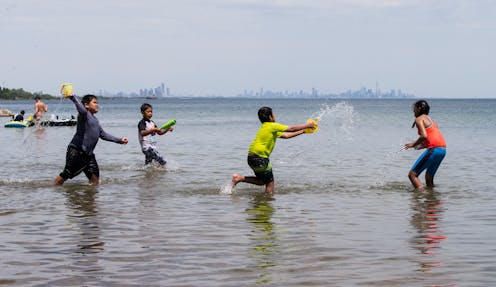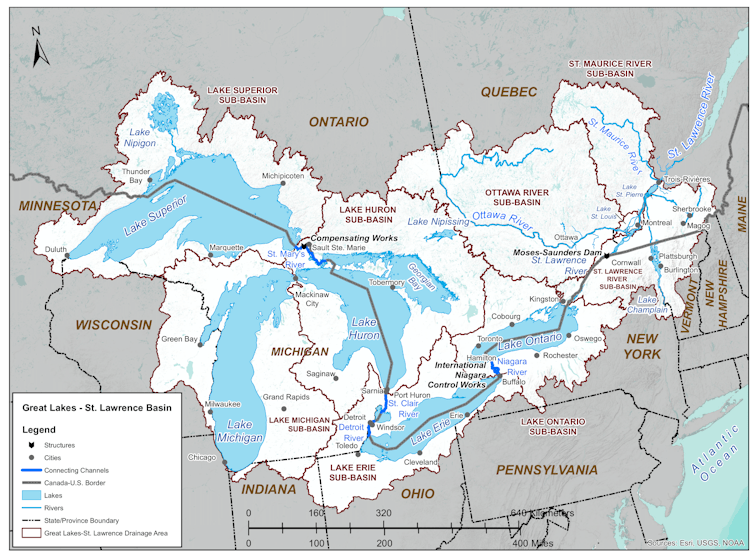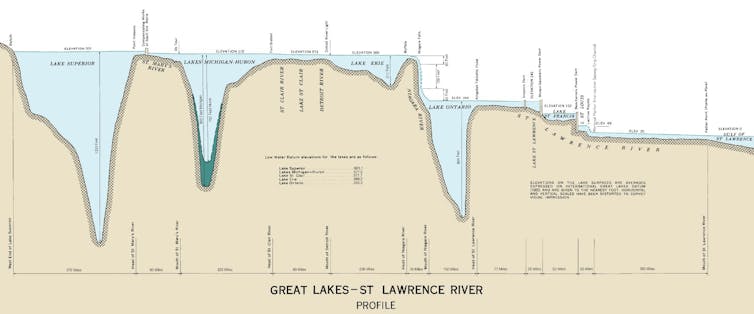Restoring the Great Lakes: After 50 years of US-Canada joint efforts, some success and lots of unfin
Cleaning up the Great Lakes was a big job when the US and Canada undertook it in 1972. Today it’s far more challenging.

The Great Lakes cover nearly 95,000 square miles (250,000 square kilometers) and hold over 20% of Earth’s surface fresh water. More than 30 million people in the U.S. and Canada rely on them for drinking water. The lakes support a multibillion-dollar maritime economy, and the lands around them provided many of the raw materials – timber, coal, iron – that fueled the Midwest’s emergence as an industrial heartland.
Despite their enormous importance, the lakes were degraded for well over a century as industry and development expanded around them. By the 1960s, rivers like the Cuyahoga, Buffalo and Chicago were so polluted that they were catching fire. In 1965, Maclean’s magazine called Lake Erie, the smallest and shallowest Great Lake, “an odorous, slime-covered graveyard” that “may have already passed the point of no return.” Lake Ontario wasn’t far behind.
In 1972, the U.S. and Canada signed the Great Lakes Water Quality Agreement, a landmark pact to clean up the Great Lakes. Now, 50 years later, they have made progress, but there are new challenges and much unfinished business.
I study the environment and have written four books on U.S.-Canadian management of their shared border waters. In my view, the Great Lakes Water Quality Agreement was a watershed moment for environmental protection and an international model for regulating transboundary pollution. But I believe the people of the U.S. and Canada failed the Great Lakes by becoming complacent too soon after the pact’s early success.

Starting with phosphates
A major step in Canada-U.S. joint management of the Great Lakes came in 1909 when they signed the Boundary Waters Treaty. The Great Lakes Water Quality Agreement built on this foundation by creating a framework to allow the two countries to cooperatively restore and protect these border waters.
However, as an executive agreement, rather than a formal government-to-government treaty, the pact has no legal mechanisms for enforcement. Instead, it relies on the U.S. and Canada to fulfill their commitments. The International Joint Commission, an agency created under the Boundary Waters Treaty, carries out the agreement and tracks progress toward its goals.
The agreement set common targets for controlling a variety of pollutants in Lake Erie, Lake Ontario and the upper St. Lawrence River, which were the most polluted section of the Great Lakes system. One key aim was to reduce nutrient pollution, especially phosphates from detergents and sewage. These chemicals fueled huge blooms of algae that then died and decomposed, depleting oxygen in the water.
Like national water pollution laws enacted at the time, these efforts focused on point sources – pollutants released from discreet, readily identifiable points, such as discharge pipes or wells.

Early results were encouraging. Both governments invested in new sewage treatment facilities and convinced manufacturers to reduce phosphate loads in detergents and soaps. But as phosphorus levels in the lakes declined, scientists soon detected other problems.
Toxic contaminants
In 1973, scientists reported a perplexing find in fish from Lake Ontario: mirex, a highly toxic organochloride pesticide used mainly to kill ants in the southeast U.S. An investigation revealed that the Hooker Chemical company was discharging mirex from its plant in Niagara Falls, New York. The contamination was so severe that New York State banned eating popular types of fish such as coho salmon and lake trout from Lake Ontario from 1976 to 1978, shutting down commercial and sport fishing in the lake.
In response to this and other findings, the U.S. and Canada updated the Great Lakes Water Quality Agreement in 1978 to cover all five lakes and focus on chemicals and toxic substances. This version formally adopted an ecosystem approach to pollution control that considered interactions between water, air and land – perhaps the first international agreement to do so.
In 1987, the two countries identified the most toxic hot spots around the lakes and adopted action plans to clean them up. However, as scholars of North American environmental regulations acknowledge, both nations too often allowed industries to police themselves.
Since the 1990s, studies have identified toxic pollutants including PCBs, DDT and chlordane in and around the Great Lakes, as well as lead, copper, arsenic and others. Some of these chemicals continued to show up because they were persistent and took a long time to break down. Others were banned but leached from contaminated sites and sediments. Still others came from a range of point and nonpoint sources, including many industrial sites concentrated on shorelines.
Many hazardous sites have been slowly cleaned up. However, toxic pollution in the Great Lakes remains a colossal problem that is largely unappreciated by the public, since these substances don’t always make the water look or smell foul. Numerous fish advisories are still in effect across the region because of chemical contamination. Industries constantly bring new chemicals to market, and regulations lag far behind.
Nonpoint sources
Another major challenge is nonpoint source pollution – discharges that come from many diffuse sources, such as runoff from farm fields.
Nitrogen levels in the lakes have risen significantly because of agriculture. Like phosphorus, nitrogen is a nutrient that causes large blooms of algae in fresh water; it is one of the main ingredients in fertilizer, and is also found in human and animal waste. Sewage overflows from cities and waste and manure runoff from industrial agriculture carry heavy loads of nitrogen into the lakes.
As a result, algal blooms have returned to Lake Erie. In 2014, toxins in one of those blooms forced officials in Toledo, Ohio, to shut off the public water supply for half a million people.
One way to address nonpoint source pollution is to set an overall limit for releases of the problem pollutant into local water bodies and then work to bring discharges down to that level. These measures, known as Total Maximum Daily Loads, have been applied or are in development for parts of the Great Lakes basin, including western Lake Erie.
But this strategy relies on states, along with voluntary steps by farmers, to curb pollution releases. Some Midwesterners would prefer a regional approach like the strategy for Chesapeake Bay, where states asked the U.S. government to write a sweeping federal TMDL for key pollutants for the bay’s entire watershed.
In 2019, Toledo voters adopted a Lake Erie Bill of Rights that would have permitted citizens to sue when Lake Erie was being polluted. Farmers challenged the measure in court, and it was declared unconstitutional.
Warming and flooding
Climate change is now complicating Great Lakes cleanup efforts. Warmer water can affect oxygen concentrations, nutrient cycling and food webs in the lakes, potentially intensifying problems and converting nuisances into major challenges.
Flooding driven by climate change threatens to contaminate public water supplies around the lakes. Record-high water levels are eroding shorelines and wrecking infrastructure. And new problems are emerging, including microplastic pollution and “forever chemicals” such as PFAS and PFOA.
It will be challenging for the U.S. and Canada to make progress on this complex set of problems. Key steps include prioritizing and funding cleanup of toxic zones, finding ways to halt agricultural runoff and building new sewer and stormwater infrastructure. If the two countries can muster the will to aggressively tackle pollution problems, as they did with phosphates in the 1970s, the Great Lakes Water Quality Agreement gives them a framework for action.
Daniel Macfarlane has received funding from the Social Sciences and Humanities Research Council and Western Michigan University.
Read These Next
West Antarctica’s history of rapid melting foretells sudden shifts in continent’s ‘catastrophic’ geo
A picture of what West Antarctica looked like when its ice sheet melted in the past can offer insight…
From truce in the trenches to cocktails at the consulate: How Christmas diplomacy seeks to exploit s
World leaders like to talk up peace at Christmastime. But alongside the tales of seasonal breaks in…
How to reduce gift-giving stress with your kids – a child psychologist’s tips for making magic and a
Depending on family circumstances and a child’s personality type, gift giving runs the gamut of fun…






